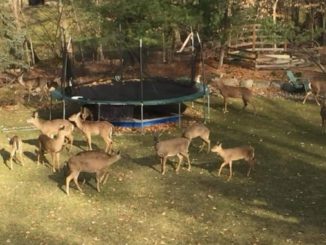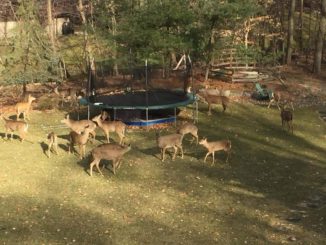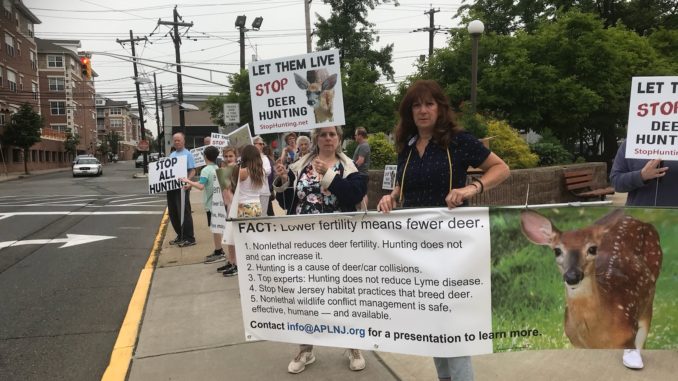
ENGLEWOOD, N.J.—A top state fish and wildlife official told about 40 northern Bergen County public officials—including six mayors—that they should not wait for “regional deer management” to occur and instead should take action alone or with a nearby town to help control rising deer populations at a June 5 deer forum in Englewood.
Carole Stanko, chief, state Department of Environmental Protection Division of Fish and Wildlife Management, said public officials should reach out to her, do research and meet with neighboring towns to address deer concerns and not wait for regional action.
She said she has been addressing North Jersey groups for six years and little collective action has occurred to reduce deer numbers.
She cited Saddle River’s recent 2018-2019 regulated bowhunt—which killed 135 deer—as one example to reduce deer and noted River Vale’s upcoming bowhunt in 2019.
River Vale Township Council members there recently “paused” the bowhunt decision to hear more public input. Mayor Glen Jasionowski—who attended the forum—told officials June 5 that though he was personally opposed to hunting, “people put us in place to make those tough decisions” and the public safety of residents was at risk due to a spike in deer-vehicle collisions.
Jasionowski said a drone deer survey revealed nearly 600 deer in town. He said “you have two choices in this room: do nothing or have a hunt. Nothing else has been approved in the state.”
He said half of the council opposes hunting but a hunt is the only state-approved method for reducing deer population.
Previously, the state rejected Saddle River’s proposal for a sterilization program, deeming it ineffective and experimental.
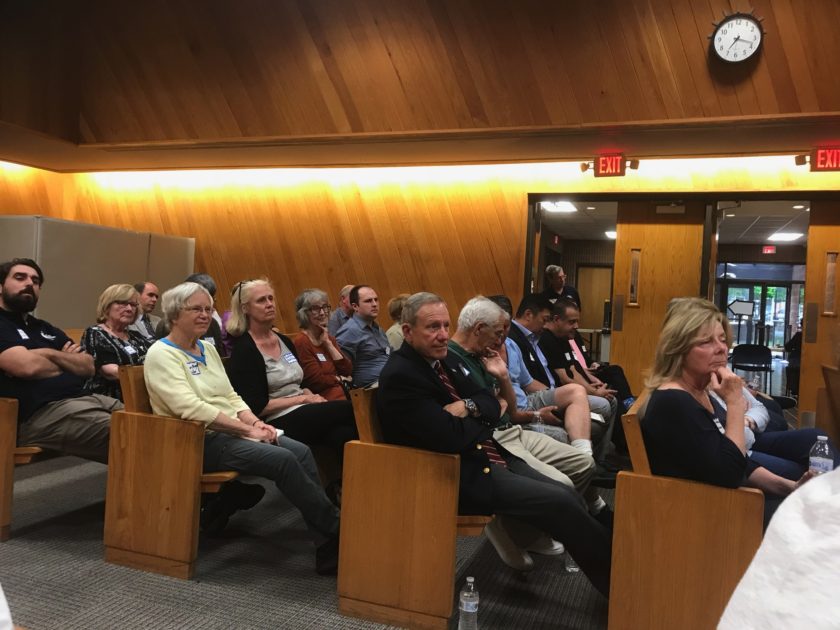
‘Let Them Live’
Prior to the 7 p.m. forum’s start, about 40 protesters from Animal Protection League of New Jersey and The League of Humane Voters marched in front of the Municipal Court Room at 73 South Van Brunt Street holding signs such as “Let Them Live / Stop Deer Hunting,” “Stop All Hunting” and “They Feel Pain, They Suffer—Just Like You.”
Stanko provided a presentation on deer biology, habitats and examined non-lethal and lethal options for deer population control. She said the only effective methods for controlling deer population are lethal methods, such as hunting or trap and kill.
Following presentations by Stanko and earlier two representatives from an animal rights group promoting non-lethal options for deer management, a question and answer session among public officials turned into a 45-minute wide-ranging discussion of deer management options, with mayors wondering what the next steps should be given public opposition to hunting in Bergen County.
Concluding her presentation, Stanko recommended that the Bergen County Park System and Palisades Interstate Park Commission get on board with allowing hunting, noting county parks include about 9,000 acres and the interstate park about 2,500 acres.
Previously county officials have not supported hunting, and a representative from Palisade Interstate Park Commission did not attend.
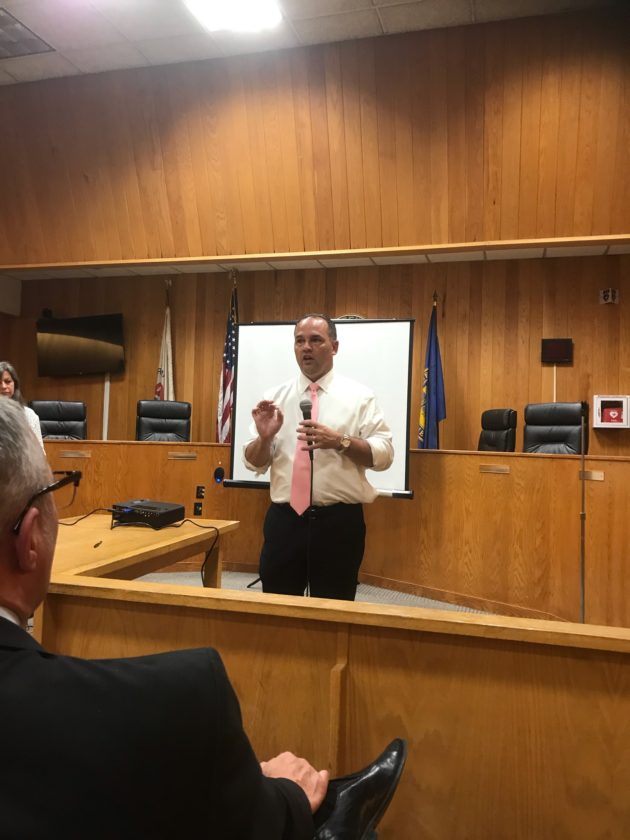
‘Comfort level’ important
“This is a personal selection on your part. The Division of Fish and Wildlife is not here to tell you what you should be doing,” said Stanko, noting each town has its own “comfort level” in addressing deer population concerns. She said the division would provide information or assistance to any community requesting it.
“I’ve heard it bandied about that ‘we have to go regional or go home.’ I don’t necessarily agree with that. Would a regional approach be more effective? Yeah, sure it would. But you don’t have to agree. Each township doesn’t have to do the exact same thing. They have to do what’s comfortable for them and if their neighbor does what’s comfortable for them, well great, then you have a regional approach…do what’s right for your municipality,” Stanko said.
Stanko provided a short checklist for municipalities to undertake to decide what local deer management options to pursue such as identifying open space, surveying residents, speaking with neighboring municipal officials, tallying deer-vehicle collisions, collecting data on negative deer impacts, defining objectives, and communicating with residents.
‘A regional plan’
Tenafly Mayor Peter Rustin said he came to the forum hoping to “put together a regional plan” for deer management and wondered about the impacts of a deer exclosure fence erected on 60 acres of Flat Rock Brook nature preserve in Englewood. He noted the protesters outside probably outnumbered the officials inside the forum.
“Garnering the political will for a lethal program, I don’t want to say it’s next to impossible cause River Vale may do it,” Rustin said. “I hear two sides to what happened in Saddle River…
“I was very encouraged to be invited to what I thought would be a regional opportunity to do a regional plan,” Rustin said.
Rustin offered to host another forum later in Tenafly to continue discussions if the borough council approves such a future meeting.
Rustin said when Flat Rock Brook excluded deer from 60 acres with a fence, “some of [the deer] are in my backyard” and he urged towns to cooperate together instead of acting separately.
“What we really could use is a non-lethal plan because I think you would get a lot of cooperation very quickly. Englewood, Tenafly, Alpine, Palisades Interstate Park—we’re all suffering because there is no plan, and hopefully next time we meet, we’ll have a plan or something we can discuss,” Rustin suggested.
Wildes said “it can’t be a political approach” for deer management.
When he asked Stanko if non-lethal methods worked, she said the division only favored a lethal approach because “it’s what works.” Wildes then asked the mayors present if they would consider a lethal approach to deer management “because people aren’t there yet” and only Jasionowski raised his hand in favor of a lethal approach.
Wildes said the public officials needed to make a start on the issue and work together.
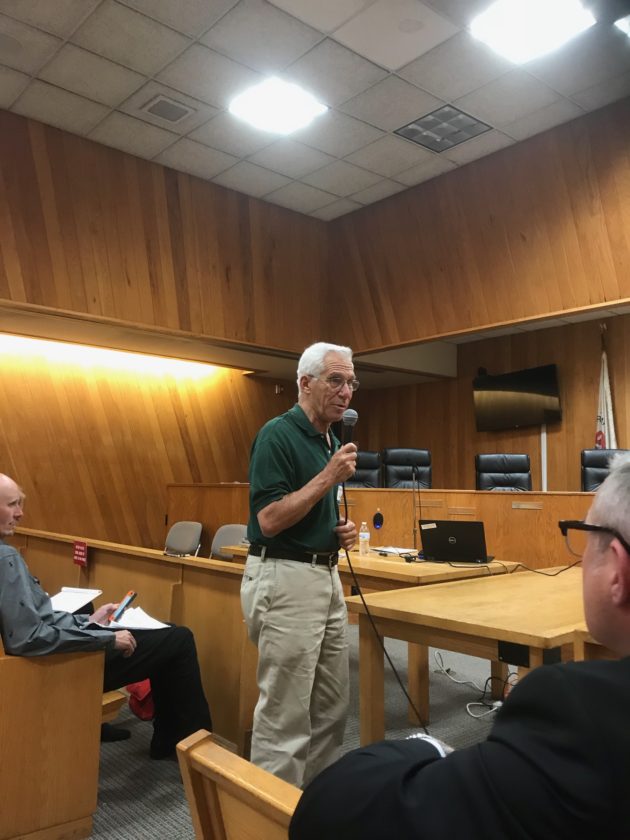
‘Embrace science, facts’
“I want this to be productive…I don’t want to come back here another year..I’d like to embrace the science, the facts and then come up with something or set it aside for real reasons,” Wildes said.
Stanko said New Jersey offers prime “edge habitat” for deer where forests adjoin new developments, roadways, and other open spaces. She went through non-lethal options including types of deer repellents, electric fences, roadside reflectors, deer whistles and roadway signage (to slow drivers) and discussed the limited effectiveness of each.
She said the non-lethal trap-and-transfer method “was no longer on the table” due to over 30 percent deer mortality during transfer and virtually no areas willing to accept deer.
She said in Princeton a program to bait and trap deer and kill them using a bolt gun, similar to livestock slaughter, was undertaken.
Stanko noted most areas statewide—except for Bergen County—allow hunting on county lands. She called hunting “the h-word” and noted hunters receive mandatory hunter education and said that bowhunting was “safe, effective and efficient” for killing deer.
She said animal advocates’ claims that 50 percent of deer are wounded and not killed by bowhunters is untrue.
She also recommended towns pass an ordinance prohibiting wildlife feeding and recommended Princeton’s ordinance which permits bird feeders but restricts use.
Prior to Stanko’s talk, Angi Metler, Animal Protection League of New Jersey’s executive director, and Mark Nagelhout, an APLNJ member, spoke on non-lethal methods and directly addressed previous statements made by Stanko regarding facts or claims they had made but Stanko publicly disputed.
Metler questioned “facts not opinion” and so-called “sound science” that Stanko presented.
“It comes as no surprise that state wildlife agencies designed to service hunters and industry are under professional fire for relying on poor science or none at all,” said Metler.
“The Division of Fish and Wildlife’s studied condescension, those who disagree are well-meaning but naive,” said Metler. “Stanko tells audiences that we at APLNJ think division employees are mad scientists in the basement making more deer, [this] disrespects the audience.’”
“[Her] whisper campaign would have you believe that humane organization professionals are biased simpletons and that the hunters at her agency and groups partnered with the Archery Trade Association are the soul of objectivity, purveyors of the vaunted ‘sound science,’” Metler charged.
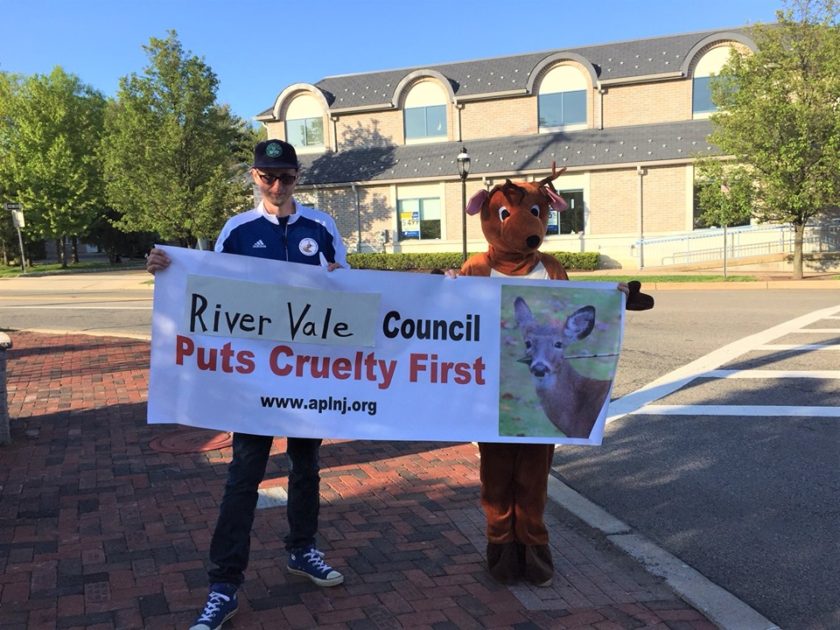
‘Killing is hardly success’
“By lay definition, three decades of cruel, perpetual and expensive killing of a graceful native species is hardly ‘success.’ Yet some routinely claim success, promise a quality hunting experience as breeding boomerangs under killing regimes that push and pull deer from one area to another,” said Metler.
Stanko said New Jersey had an estimated 133,000 deer statewide last year and 51,000 were harvested.
The state deer census is based on hunter harvest, and no deer estimates are available for Bergen County due to no current hunting allowed, Stanko said.
The deer forum was organized by Englewood’s Deer Task Force Committee, chaired by Dr. Lisa Wisotsky and moderated by Mayor Michael Wildes.
The task force sponsored a state Fish and Wildlife presentation open to residents in December at Englewood Hospital, its first forum following release of a city deer census report showing a dramatic increase in city deer population.
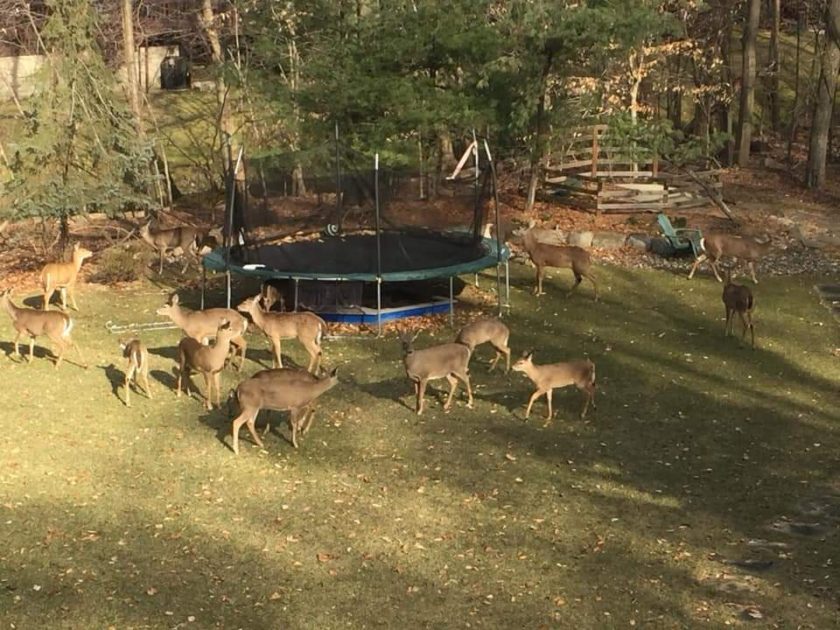
Forum attendees
Also attending were Closter Mayor John Glidden, Demarest Mayor Melinda Iannuzzi, and Bergenfield Mayor Norman Schmelz, along with dozens of other officials.
Some others included: Flat Rock Brook Nature Center Executive Director Stephen Wiessner, River Vale Councilmen Ari Ben-Yishay and Mark Bromberg, Englewood Councilmen Wayne Hamer and Charles Cobb and Councilwoman Cheryl Rosenberg; Tenafly Councilman Maxim Basch, Old Tappan Councilman Jin Yhu, Norwood Councilman Barry Scott, Northvale Councilman Joseph McGuire, and Teaneck township manager Dean Kazinci, and Englewood Deputy Police Chief Gregory Halstead.
Wildes urged attending mayors to host similar forums in their towns and Rustin said he would request his council to host such a forum.
Wisotsky said representatives from 18 of 25 invited Bergen County towns were at the forum, including Norwood, Harrington Park, Demarest, Bergenfield, Tenafly, River Vale, Teaneck, Englewood, Closter, Fort Lee, Leonia, New Milford, Hillsdale, Old Tappan, Ridgefield, Park Ridge, and Northvale.
Also at the forum was Bergen County Assistant Director of Parks and Recreation Ron Subramanian, city Health Director James Fedorko and an aide from U.S. Rep. Josh Gottheimer’s office.

